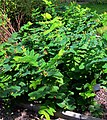Blood St. John's wort
| Blood St. John's wort | ||||||||||||
|---|---|---|---|---|---|---|---|---|---|---|---|---|

St. John's wort ( Hypericum androsaemum ) |
||||||||||||
| Systematics | ||||||||||||
|
||||||||||||
| Scientific name | ||||||||||||
| Hypericum androsaemum | ||||||||||||
| L. |
The blood-John's wort ( Hypericum androsaemum ) or man blood is a plant from the genus of hypericum ( Hypericum ) in the family of hypericaceae (Hypericaceae).
description
Vegetative characteristics
The blood St. John's wort is an evergreen, bare shrub from 30 to 80, rarely up to 100 centimeters in height. Its creeping to upright trunk is densely branched. On the loosely branched, upright to spreading branches there are two narrow longitudinal ridges.
The opposite leaves are seated. The simple leaf blade is 3 to 10 centimeters long and 1.5 to 6 centimeters wide and is narrow to broadly ovate with a mostly heart-shaped blade base and a blunt to rounded upper end. The leaves are leathery and often encompass the stem, their upper side is dark green, the underside, however, blue-green, they have entire margins and are translucent dotted due to oil glands.
Generative characteristics
The flowering period extends from June to August. The long-stalked flowers sit individually or in small groups in the axils of lanceolate bracts , where together they form terminal sham umbels.
The hermaphroditic flowers have a diameter of 15 to 30 millimeters and are radially symmetrical and five-fold with a double flower envelope . The sepals of different sizes are egg-shaped with a length of 5 to 15 millimeters and a width of 3 to 6 millimeters with a pointed to blunt upper end. Its outside is sparsely covered by glandular hair and does not fall off, it is repulsed on the ripe fruits. The sloping, pale yellow petals are 6 to 11 millimeters long and 4 to 6 millimeters wide and are obovate with a blunt to rounded upper end. The numerous stamens are arranged in five groups, which are fused at the base; they tower above the crown.
The fleshy, bald berry is spherical to spindle-shaped with a length of 6 to 10 millimeters. It is initially red-brown, but when ripe it is shiny black. The seeds are about 1 millimeter long, oval to cylindrical and striped lengthways through pit-shaped depressions.
Chromosome number
The number of chromosomes is 2n = 40.
Occurrence
The distribution area of the blood St. John's wort extends from western and southern Europe to Asia Minor . St. John's wort can be found from Portugal in the west to Turkey in the east. To the north it occurs in the Atlantic climate as far as Ireland, in Germany and the Netherlands this species is absent.
The blood St. John's wort grows in light forests as well as in shady bushes. There are no special demands on the soil , but St. John's wort is mainly found in shady locations in the flat and hilly regions.
Folk medicine
In the past, wound ointments were made from the leaves of St. John's wort .
photos
literature
- Gunter Steinbach (Ed.): Shrub trees (Steinbach's natural guide). Mosaik Verlag GmbH, Munich 1996, ISBN 3-576-10560-3 .
Individual evidence
- ↑ Hypericum androsaemum at Tropicos.org. In: IPCN Chromosome Reports . Missouri Botanical Garden, St. Louis
- ^ Hatfield, Gabrielle .: Medicinal plants in folk tradition: an ethnobotany of Britain & Ireland . Timber Press, Portland, Or. 2004, ISBN 978-1-60469-429-1 , pp. 103 f .
Web links
- Hypericum androsaemum L., Mannsblut-Hartheu. In: FloraWeb.de.
- Hypericum androsaemum L. In: Info Flora , the national data and information center for Swiss flora . Retrieved December 10, 2015.
- Thomas Meyer: Data sheet with identification key and photos at Flora-de: Flora von Deutschland (old name of the website: Flowers in Swabia )
- Günther Blaich: data sheet with photos.
- Mood enhancers with side effects , Stern dated December 1, 2006





